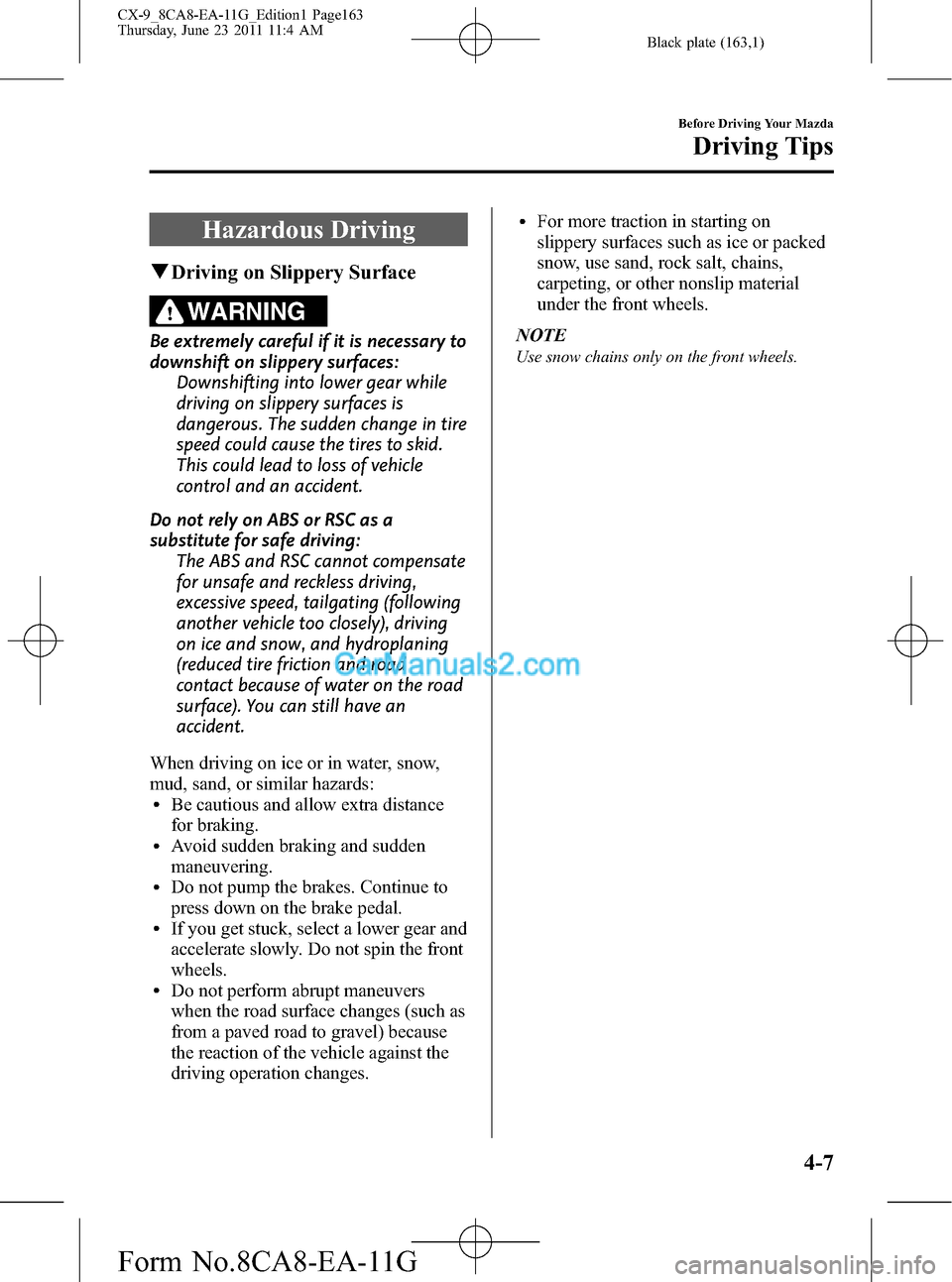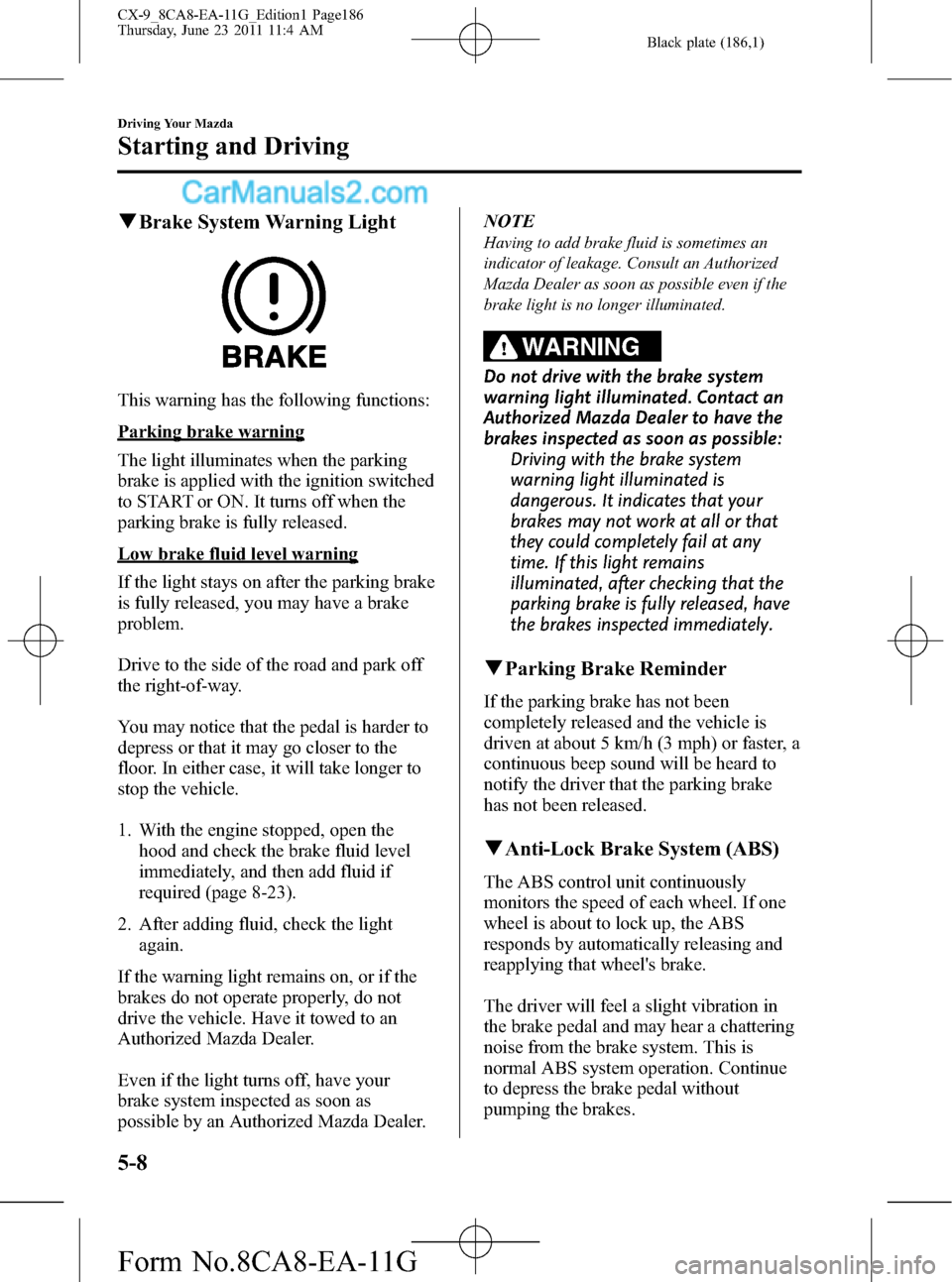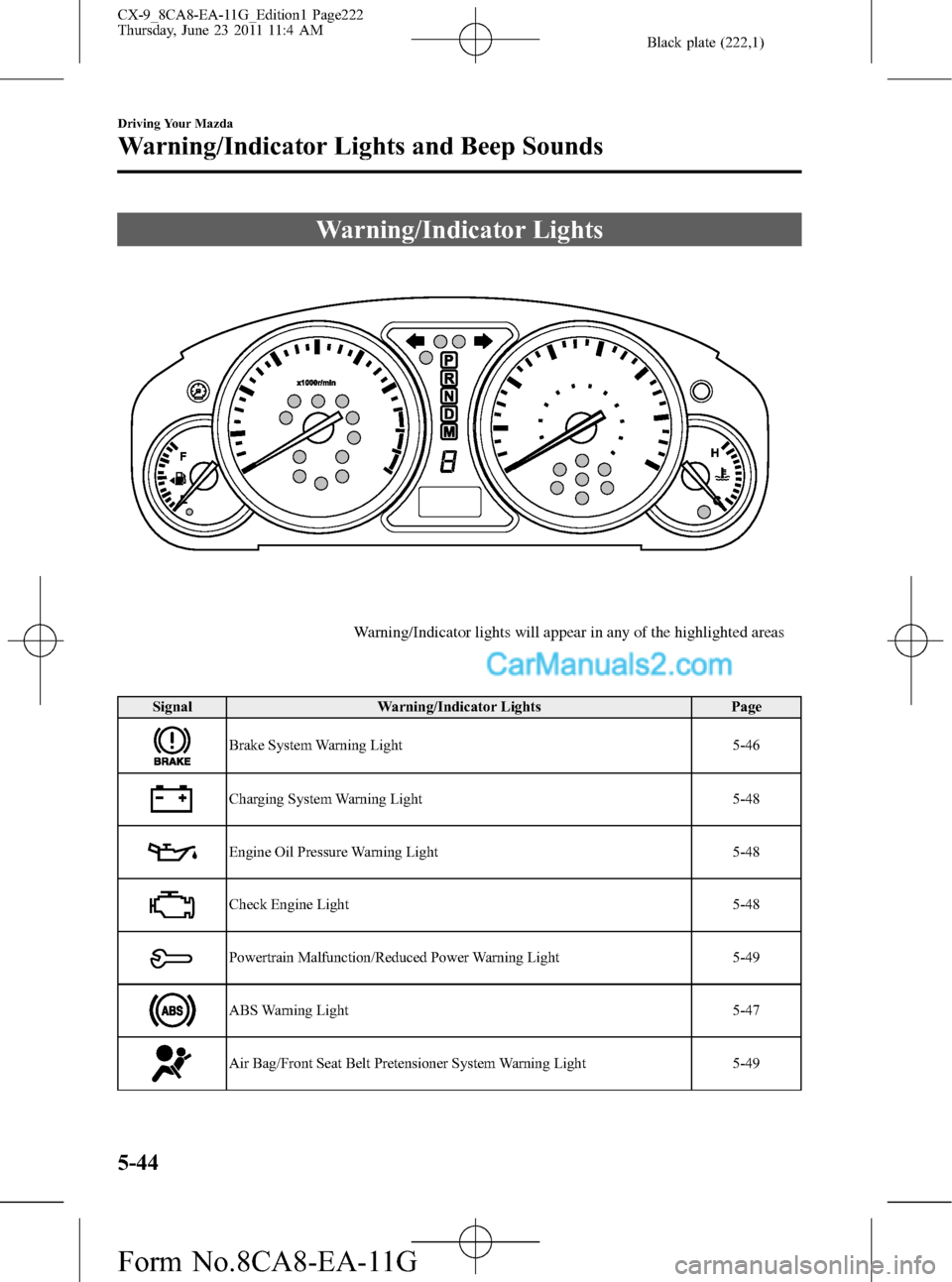ABS MAZDA MODEL CX-9 2012 Owners Manual (in English)
[x] Cancel search | Manufacturer: MAZDA, Model Year: 2012, Model line: MODEL CX-9, Model: MAZDA MODEL CX-9 2012Pages: 604, PDF Size: 13.45 MB
Page 33 of 604

Black plate (33,1)
WARNING
Always wear your seat belt and make sure all occupants are properly restrained:
Not wearing a seat belt is extremely dangerous. During a collision, occupants not
wearing seat belts could hit someone or things inside the vehicle or even be thrown
out of the vehicle. They could be seriously injured or even killed. In the same
collision, occupants wearing seat belts would be much safer.
Do not wear twisted seat belts:
Twisted seat belts are dangerous. In a collision, the full width of the belt is not
available to absorb the impact. This puts more force on the bones beneath the belt,
which could cause serious injury or death. So, if your seat belt is twisted, you must
straighten the seat belt to remove any twists and to allow the full width of the belt to
be used.
Never use one seat belt on more than one person at a time:
Using one seat belt for more than one person at a time is dangerous. A seat belt
used in this way cannot spread the impact forces properly and the two passengers
could be crushed together and seriously injured or even killed. Never use one belt for
more than one person at a time and always operate the vehicle with each occupant
properly restrained.
Do not operate a vehicle with a damaged seat belt:
Using a damaged seat belt is dangerous. An accident could damage the belt
webbing of the seat belt in use. A damaged seat belt cannot provide adequate
protection in a collision. Have an Authorized Mazda Dealer inspect all seat belt
systems in use during an accident before they are used again.
Have your seat belts changed immediately if the pretensioner or load limiter has
been expended:
Always have an Authorized Mazda Dealer immediately inspect the front seat belt
pretensioners and air bags after any collision. Like the air bags, the front seat belt
pretensioners and load limiters will only function once and must be replaced after
any collision that caused them to deploy. A seat belt with an expended pretensioner
or load limiter is still better than wearing no seat belt at all; however, if the front
seat belt pretensioners and load limiters are not replaced, the risk of injury in a
collision will increase.
In a rollover crash, an unbelted person is significantly more likely to die than a
person wearing a seat belt.
Essential Safety Equipment
Seat Belt Systems
2-21
CX-9_8CA8-EA-11G_Edition1 Page33
Thursday, June 23 2011 11:3 AM
Form No.8CA8-EA-11G
Page 163 of 604

Black plate (163,1)
Hazardous Driving
qDriving on Slippery Surface
WARNING
Be extremely careful if it is necessary to
downshift on slippery surfaces:
Downshifting into lower gear while
driving on slippery surfaces is
dangerous. The sudden change in tire
speed could cause the tires to skid.
This could lead to loss of vehicle
control and an accident.
Do not rely on ABS or RSC as a
substitute for safe driving:
The ABS and RSC cannot compensate
for unsafe and reckless driving,
excessive speed, tailgating (following
another vehicle too closely), driving
on ice and snow, and hydroplaning
(reduced tire friction and road
contact because of water on the road
surface). You can still have an
accident.
When driving on ice or in water, snow,
mud, sand, or similar hazards:
lBe cautious and allow extra distance
for braking.
lAvoid sudden braking and sudden
maneuvering.
lDo not pump the brakes. Continue to
press down on the brake pedal.
lIf you get stuck, select a lower gear and
accelerate slowly. Do not spin the front
wheels.
lDo not perform abrupt maneuvers
when the road surface changes (such as
from a paved road to gravel) because
the reaction of the vehicle against the
driving operation changes.
lFor more traction in starting on
slippery surfaces such as ice or packed
snow, use sand, rock salt, chains,
carpeting, or other nonslip material
under the front wheels.
NOTE
Use snow chains only on the front wheels.
Before Driving Your Mazda
Driving Tips
4-7
CX-9_8CA8-EA-11G_Edition1 Page163
Thursday, June 23 2011 11:4 AM
Form No.8CA8-EA-11G
Page 168 of 604

Black plate (168,1)
Driving In Flooded Area
WARNING
Dry wet brakes by driving very slowly
and applying the brakes lightly until
brake performance returns to normal:
Driving with wet brakes is
dangerous. Increased stopping
distance or the vehicle pulling to one
side when braking could result in a
serious accident. Light braking will
indicate whether the brakes have
been affected.
CAUTION
Do not drive the vehicle on flooded
roads as it could cause short
circuiting of electrical/electronic
parts, or engine damage or stalling
from water absorption. If the vehicle
has been immersed in water, consult
an Authorized Mazda Dealer.
Overloading
WARNING
Be careful not to overload your vehicle:
The gross axle weight rating (GAWR)
and the gross vehicle weight rating
(GVWR) of your vehicle are on the
Motor Vehicle Safety Standard Label
on the driver's door frame. Exceeding
these ratings can cause an accident
or vehicle damage. You can estimate
the weight of your load by weighing
the items (or people) before putting
them in the vehicle.
4-12
Before Driving Your Mazda
Driving Tips
CX-9_8CA8-EA-11G_Edition1 Page168
Thursday, June 23 2011 11:4 AM
Form No.8CA8-EA-11G
Page 186 of 604

Black plate (186,1)
qBrake System Warning Light
This warning has the following functions:
Parking brake warning
The light illuminates when the parking
brake is applied with the ignition switched
to START or ON. It turns off when the
parking brake is fully released.
Low brake fluid level warning
If the light stays on after the parking brake
is fully released, you may have a brake
problem.
Drive to the side of the road and park off
the right-of-way.
You may notice that the pedal is harder to
depress or that it may go closer to the
floor. In either case, it will take longer to
stop the vehicle.
1. With the engine stopped, open the
hood and check the brake fluid level
immediately, and then add fluid if
required (page 8-23).
2. After adding fluid, check the light
again.
If the warning light remains on, or if the
brakes do not operate properly, do not
drive the vehicle. Have it towed to an
Authorized Mazda Dealer.
Even if the light turns off, have your
brake system inspected as soon as
possible by an Authorized Mazda Dealer.NOTE
Having to add brake fluid is sometimes an
indicator of leakage. Consult an Authorized
Mazda Dealer as soon as possible even if the
brake light is no longer illuminated.
WARNING
Do not drive with the brake system
warning light illuminated. Contact an
Authorized Mazda Dealer to have the
brakes inspected as soon as possible:
Driving with the brake system
warning light illuminated is
dangerous. It indicates that your
brakes may not work at all or that
they could completely fail at any
time. If this light remains
illuminated, after checking that the
parking brake is fully released, have
the brakes inspected immediately.
qParking Brake Reminder
If the parking brake has not been
completely released and the vehicle is
driven at about 5 km/h (3 mph) or faster, a
continuous beep sound will be heard to
notify the driver that the parking brake
has not been released.
qAnti-Lock Brake System (ABS)
The ABS control unit continuously
monitors the speed of each wheel. If one
wheel is about to lock up, the ABS
responds by automatically releasing and
reapplying that wheel's brake.
The driver will feel a slight vibration in
the brake pedal and may hear a chattering
noise from the brake system. This is
normal ABS system operation. Continue
to depress the brake pedal without
pumping the brakes.
5-8
Driving Your Mazda
Starting and Driving
CX-9_8CA8-EA-11G_Edition1 Page186
Thursday, June 23 2011 11:4 AM
Form No.8CA8-EA-11G
Page 187 of 604

Black plate (187,1)
WARNING
Do not rely on ABS or RSC as a
substitute for safe driving:
The ABS and RSC cannot compensate
for unsafe and reckless driving,
excessive speed, tailgating (following
another vehicle too closely), driving
on ice and snow, and hydroplaning
(reduced tire friction and road
contact because of water on the road
surface). You can still have an
accident.
NOTE
lBraking distances may be longer on loose
surfaces (snow or gravel, for example)
which usually have a hard foundation. A
vehicle with a normal braking system may
require less distance to stop under these
conditions because the tires will build up a
wedge of surface layer when the wheels
skid.
lThe sound of the ABS operating may be
heard when starting the engine or
immediately after starting the vehicle,
however, it does not indicate a malfunction.
qABS Warning Light
The warning light stays on for a few
seconds when the ignition is switched
ON.If the ABS warning light stays on while
you're driving, the ABS control unit has
detected a system malfunction. If this
occurs, your brakes will function normally
as if the vehicle had no ABS.
Should this happen, consult an Authorized
Mazda Dealer as soon as possible.
NOTE
lWhen the engine is jump-started to charge
the battery, uneven rpm occurs and the ABS
warning light may illuminate. If this occurs,
it is the result of the weak battery and does
not indicate an ABS malfunction.
Recharge the battery.
lThe brake assist system does not operate
while the ABS warning light is illuminated.
qElectronic Brake Force
Distribution System Warning
If the electronic brake force distribution
control unit determines that some
components are operating incorrectly, the
control unit may illuminate the brake
system warning light and the ABS
warning light on simultaneously. The
problem is likely to be the electronic
brake force distribution system.
Driving Your Mazda
Starting and Driving
5-9
CX-9_8CA8-EA-11G_Edition1 Page187
Thursday, June 23 2011 11:4 AM
Form No.8CA8-EA-11G
Page 188 of 604

Black plate (188,1)
WARNING
Do not drive with both the ABS warning
light and brake warning light
illuminated. Have the vehicle towed to
an Authorized Mazda Dealer to have
the brakes inspected as soon as
possible:
Driving when the brake system
warning light and ABS warning light
are illuminated simultaneously is
dangerous.
When both lights are illuminated, the
rear wheels could lock more quickly
in an emergency stop than under
normal circumstances.
qBrake Assist
During emergency braking situations
when it is necessary to depress the brake
pedal with greater force, the brake assist
system provides braking assistance, thus
enhancing braking performance.
When the brake pedal is depressed hard or
depressed more quickly, the brakes apply
more firmly.
NOTE
lWhen the brake pedal is depressed hard or
depressed more quickly, the pedal will feel
softer but the brakes will apply more firmly.
This is a normal effect of the brake assist
operation and does not indicate a
malfunction.
lWhen the brake pedal is depressed hard or
depressed more quickly, a motor/pump
operation noise may be heard. This is a
normal effect of the brake assist and does
not indicate a malfunction.
lThe brake assist equipment does not
supersede the functionality of the vehicle's
main braking system.
qBrake Pad Wear Indicator
When the disc brake pads become worn,
the built-in wear indicators contact the
disc plates. This causes a loud screeching
noise to warn that the pads should be
replaced.
When you hear this noise, consult an
Authorized Mazda Dealer as soon as
possible.
WARNING
Do not drive with worn disc pads:
Driving with worn disc pads is
dangerous. The brakes could fail and
cause a serious accident. As soon as
you hear a screeching noise consult
an Authorized Mazda Dealer.
5-10
Driving Your Mazda
Starting and Driving
CX-9_8CA8-EA-11G_Edition1 Page188
Thursday, June 23 2011 11:4 AM
Form No.8CA8-EA-11G
Page 204 of 604

Black plate (204,1)
Dynamic Stability Control
(DSC)/Roll Stability
Control (RSC)
The Dynamic Stability Control (DSC)
automatically controls braking and engine
torque in conjunction with systems such
as ABS and TCS to help control side slip
when driving on slippery surfaces or
during sudden or evasive maneuvering,
enhancing vehicle safety.
The Roll Stability Control (RSC)
automatically controls braking and engine
torque in conjunction with systems such
as ABS and TCS to help control rolling
when cornering at a higher speed or
during sudden or evasive maneuvering,
enhancing vehicle safety.
Refer to ABS (page 5-8) and TCS (page
5-23).
DSC/RSC operation is possible at speeds
greater than 15 km/h (9 mph).
WARNING
Do not rely on the dynamic stability
control as a substitute for safe driving:
The dynamic stability control (DSC)/
Roll Stability Control (RSC) cannot
compensate for unsafe and reckless
driving, excessive speed, tailgating
(following another vehicle too
closely), and hydroplaning (reduced
tire friction and road contact because
of water on the road surface). You
can still have an accident.
When driving under bad road
conditions, lower the vehicle speed and
drive carefully:
Reckless driving and excessive speed
under any road conditions is
dangerous as it reduces vehicle
stability and operability which could
result in an accident.
5-26
Driving Your Mazda
Starting and Driving
CX-9_8CA8-EA-11G_Edition1 Page204
Thursday, June 23 2011 11:4 AM
Form No.8CA8-EA-11G
Page 222 of 604

Black plate (222,1)
Warning/Indicator Lights
Warning/Indicator lights will appear in any of the highlighted areas
Signal Warning/Indicator Lights Page
Brake System Warning Light 5-46
Charging System Warning Light 5-48
Engine Oil Pressure Warning Light 5-48
Check Engine Light 5-48
Powertrain Malfunction/Reduced Power Warning Light 5-49
ABS Warning Light 5-47
Air Bag/Front Seat Belt Pretensioner System Warning Light 5-49
5-44
Driving Your Mazda
Warning/Indicator Lights and Beep Sounds
CX-9_8CA8-EA-11G_Edition1 Page222
Thursday, June 23 2011 11:4 AM
Form No.8CA8-EA-11G
Page 225 of 604

Black plate (225,1)
qABS Warning Light
The warning light stays on for a few
seconds when the ignition is switched
ON.
If the ABS warning light stays on while
you're driving, the ABS control unit has
detected a system malfunction. If this
occurs, your brakes will function normally
as if the vehicle had no ABS.
Should this happen, consult an Authorized
Mazda Dealer as soon as possible.
NOTE
lWhen the engine is jump-started to charge
the battery, uneven rpm occurs and the ABS
warning light may illuminate. If this occurs,
it is the result of the weak battery and does
not indicate an ABS malfunction.
Recharge the battery.
lThe brake assist system does not operate
while the ABS warning light is illuminated.
qElectronic Brake Force
Distribution System Warning
If the electronic brake force distribution
control unit determines that some
components are operating incorrectly, the
control unit may illuminate the brake
system warning light and the ABS
warning light on simultaneously. The
problem is likely to be the electronic
brake force distribution system.
WARNING
Do not drive with both the ABS warning
light and brake warning light
illuminated. Have the vehicle towed to
an Authorized Mazda Dealer to have
the brakes inspected as soon as
possible:
Driving when the brake system
warning light and ABS warning light
are illuminated simultaneously is
dangerous.
When both lights are illuminated, the
rear wheels could lock more quickly
in an emergency stop than under
normal circumstances.
Driving Your Mazda
Warning/Indicator Lights and Beep Sounds
5-47
CX-9_8CA8-EA-11G_Edition1 Page225
Thursday, June 23 2011 11:4 AM
Form No.8CA8-EA-11G
Page 475 of 604

Black plate (475,1)
Towing Description
We recommend that towing be done only
by an Authorized Mazda Dealer or a
commercial tow-truck service.
Proper lifting and towing are necessary to
prevent damage to the vehicle.
Particularly when towing a AWD vehicle,
where all the wheels are connected to the
drive train, proper transporting of the
vehicle is absolutely essential to avoid
damaging the drive system. Government
and local laws must be followed.
Wheel dollies
A towed 2WD vehicle should have its
drive wheels (front wheels) off the
ground. If excessive damage or other
conditions prevent this, use wheel dollies.
When towing a 2WD vehicle with the rear
wheels on the ground, release the parking
brake.
A towed AWD vehicle must have all its
wheels off the ground.
CAUTION
Do not tow the vehicle pointed
backward with driving wheels on the
ground. This may cause internal
damage to the transaxle.
CAUTION
Do not tow with sling-type
equipment. This could damage your
vehicle. Use wheel-lift or flatbed
equipment.
In Case of an Emergency
Emergency Towing
7-21
CX-9_8CA8-EA-11G_Edition1 Page475
Thursday, June 23 2011 11:6 AM
Form No.8CA8-EA-11G